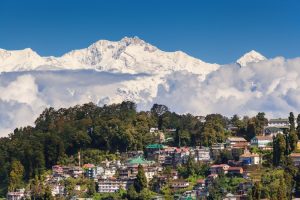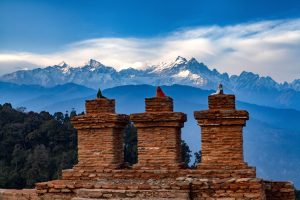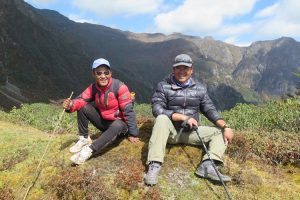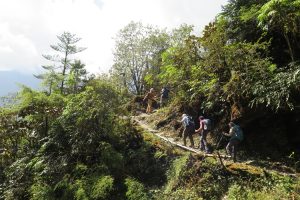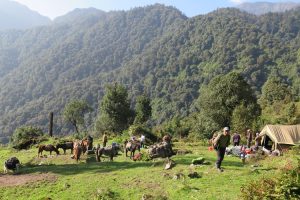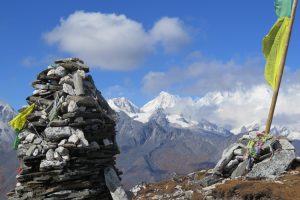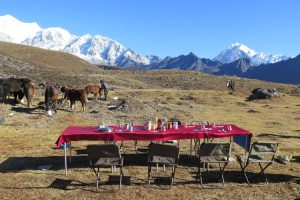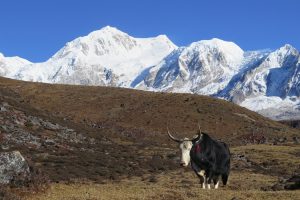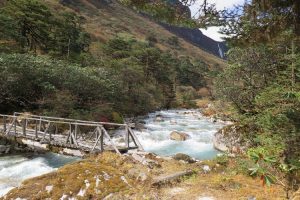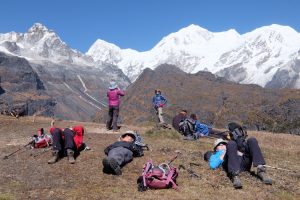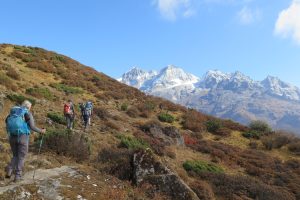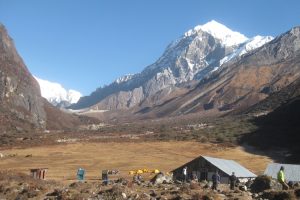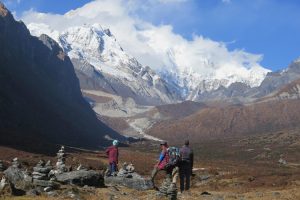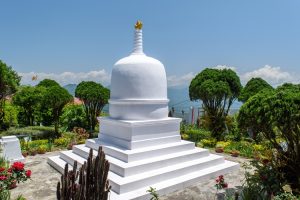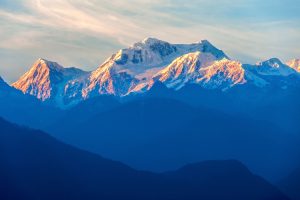India, Sikkim | Walking & Trekking
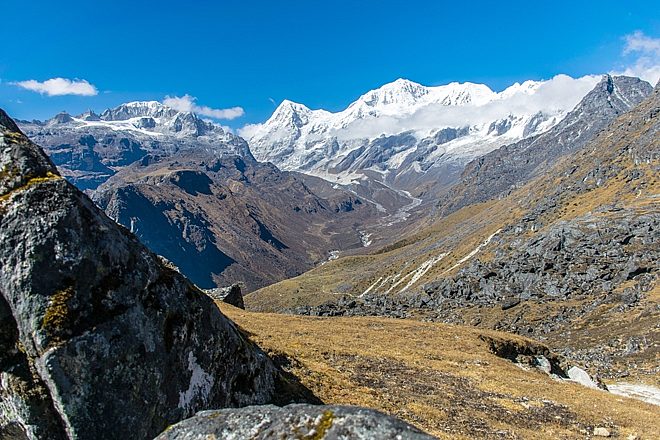
- Grade:
-
?
Vigorous / Strenuous
Vigorous: Suitable for enthusiastic hill/mountain walkers.
Strenuous: Suitable for fit individuals who have regular experience of mountain walking.
Find out more...
Vigorous / Strenuous
-
?
- Duration: 22 days from the UK
- On trek: 13 days Walk on: 1 day
- Private Departures Available
Flight inclusive from £3925, Land only from £2875
Scenic trekking beneath the world's third highest peak through the varied mountain landscapes of Sikkim.
Highlights
- Splendid Himalayan trekking with scenic camps and panoramic viewpoints.
- Genuinely remote with few other trekkers for the first eight days of the trek.
- Stunning sunrise views of Kangchenjunga and the surrounding peaks.
- Time in Darjeeling & Kalimpong to enjoy the sights.
- Full-service camping on trek and good quality centrally located hotels.
Reviews
Situated in the far northeast of India, the small state of Sikkim lies along the spine of the Himalaya, squeezed between Nepal, Tibet and Bhutan. As rich in culture, history and scenic wonders as its neighbours, Sikkim is often overlooked but this tiny green state is a world leader; in 2018 it became the UN's first 100 percent organic state beating 25 other countries and regions from across the world, including Denmark.
Kangchenjunga at 8,586m/28,169ft is undoubtedly the jewel in Sikkim's crown, and the world's third highest mountain, providing a wonderfully inspiring backdrop to Sikkim's scenic trails. Along with its majestic, mountain landscapes Sikkim is famed for a wealth of cultural attractions. Before starting your trek you will visit the bustling hill station of Darjeeling with its verdant tea plantations, colonial era architecture and celebrated mountain railway. You will also make a stopover in Pemayangtse to visit the second oldest and most important monastery in Sikkim.
Having sampled some of the cultural delights of Sikkim, it's now time to immerse yourself in its natural wonders as you set off on trek from Shayang Chola. Over the next two weeks you will experience a variety of landscapes. As you gradually ascend you encounter rhododendron forests, lush meadows, babbling streams and even a sacred lake, and every night you enjoy a first rate camping experience at superbly located sites that give you fabulous early morning vistas. The undoubted high point of the trek though is seeing the sun rise over the mighty eastern face of Kangchenjunga - undoubtedly one of the most awe-inspiring sights in the Himalaya - and a just reward for your exertions.
Private Departures
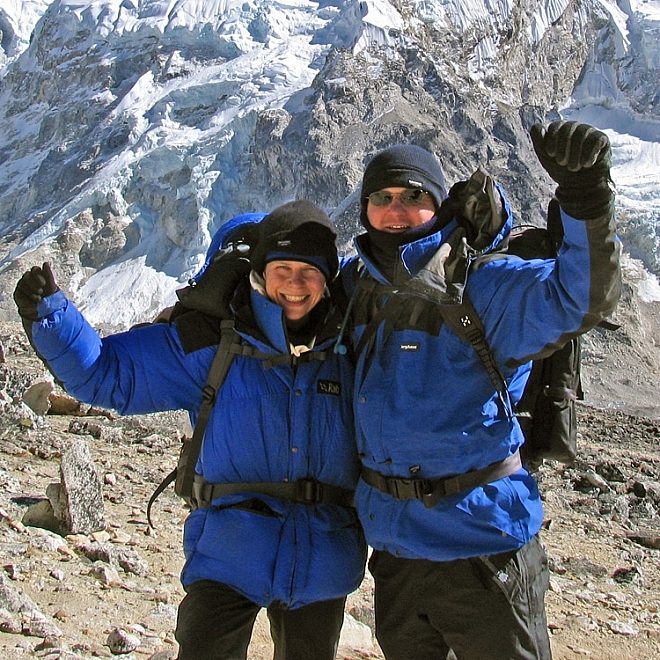
Kangchenjunga Trek Sikkim, India - Private Departures
If you would prefer to travel just with your partner, friends or family, we can arrange a private departure of this holiday. You follow the same itinerary, but travel on dates that suit you. Alternatively we can include elements of this holiday in a bespoke Tailor Made itinerary. Contact our friendly team for details and prices, and to make a booking.
At a glance
Vigorous / Strenuous
Duration: 22 days from the UK
On trek: 13 days Walk on: 1 day
Max. Altitude: 4,500m/14,764ft, Viewpoint, Day 17
Private Departures Available
Guaranteed to run for a minimum of 4 clients
Maximum group size: 12
Accommodation types: Hotels, Camping
Meal arrangements: Bed and Breakfast in Delhi. Most meals included elsewhere and on trek.
Itinerary overview
| Day | Activity |
|---|---|
| 1-2 | Fly to Delhi. |
| 3-4 | Fly to Bagdogra. Drive to Darjeeling. Sightseeing. |
| 5 | Drive to Pemayangtse. Walk to Rabdenste ruins and visit Pemayangtse Monastery. |
| 6 | Drive to Shyang Chola via Rimbi. Begin trek and camp at Chonzom. |
| 7-9 | Trek to Upper Yambung via Doban and Bichchok. |
| 10-13 | Cross the Danfe Bir Pass to Pokhari. Trek to Panding then cross the Tegyapla pass to Chauri. Descend to Bikbari. |
| 14-16 | Cross the Dzongri la pass. Rest day then trek to Kangchenjunga viewpoints and Thangsing. |
| 17-18 | Trek to Tshoka and on to Yuksom. End trek.Day. |
| 19-20 | Drive to Kalimpong, at leisure. |
| 21-22 | Drive to Bagdogra. Fly to Delhi. Fly to London. |
Leader: Sikkim trekking guide
Darjeeling, despite its relatively low altitude, has long held an important place in the history of Himalayan trekking and climbing. Sherpa Tenzing made his home here and the Himalayan Mountaineering Institute founded in the 1950s, is renowned as a centre of excellence for the training of guides. Today’s walking and trekking guides in Sikkim uphold the strong traditions and your leader will be a knowledgeable, fluent English-speaking Indian guide. He will be supported by a hard working team on trek, comprising a cook, porters, pony/dzo men and depending upon the group size, additional guides.
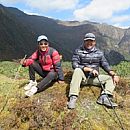
Holiday Itinerary
Day 1 - Fly London To Delhi
Fly overnight from London to Delhi.

Day 2 - Arrive Delhi. Transfer to hotel. At leisure.
On arrival at Delhi International Airport you will be met and transferred to your hotel. The rest of the day is free for you to relax after your long flight. If you would like a guided sightseeing tour this can be arranged by the Mountain Kingdoms office prior to your departure. Please contact us for further details.

Day 3 - Fly Delhi to Bagdogra. Drive to Darjeeling, 2,134m/7,001ft - 3½ hours drive.
After breakfast you will be transferred to the airport for your flight to Bagdogra. If the weather is clear, this flight, which runs parallel with the Greater Himalayan chain, will give you views of many huge peaks including Dhaulagiri and Everest. You will also enjoy your first glimpse of the Kangchenjunga Massif as you approach Darjeeling.
From the airport you drive along the windy road which takes you up from the plains to Darjeeling. Straddling a ridge in the Darjeeling-Sikkim Himalaya at 2,134m/7,001ft, and surrounded by tea plantations on all sides, Darjeeling has been a popular hill station since the British established it as a rest and recuperation (R and R) centre for their troops in the mid-1800s. The industrious British, not averse to mixing a little business with pleasure, recognised that the quality of the soil and the mild climate were ideal for tea cultivation; the forested hill slopes were soon denuded of their cover and planted with this most lucrative revenue earner. These days, people come here to escape from the heat and humidity of the north Indian plains. You will find yourself surrounded by mountain people from all over the eastern Himalaya who have come to work, to trade or, in the case of the Tibetans, as refugees. Mother Teresa spent her early years as a nun here with the sisters at Loreto Convent and Lawrence Durrell was educated at the prestigious St Joseph's College.
Darjeeling is also a popular tourist town with many visitors coming to enjoy the faded colonial grandeur and the far-reaching vistas across to the Himalayan peaks including Kangchenjunga.

Day 4 - Morning sightseeing in Darjeeling. Afternoon at leisure.
It is worth getting up early to walk to the Observatory Hill to take in the splendid mountain views. Later you will visit the Everest Museum at the Himalayan Mountaineering Institute where you can see a fascinating collection of memorabilia from some of the early expeditions to Everest. You then drive to the Tibetan Refugee Self-Help Centre where you can observe carpet making and other handicrafts,and visit the centre's shop to pick up a unique souvenir. There may also be time to visit the old Happy Valley Tea Garden to see the traditional tea-making process in action and to enjoy a good brew!
You will return to the hotel for lunch, the afternoon is free.

Day 5 - Drive to Pemayangste, 2,085m - 5½ hours. Walk to Rabdentse ruins. Visit Monastery.
After an early breakfast, you set off by jeep for the long drive to Pemayangste. Once you've checked in to your hotel at nearby Pelling you’ll enjoy a walk to see the scattered ruins of Rabdenste Palace. The palace was built by the second king of Sikkim, Tenzung Namgyal in 1670. There are fine views from the site across to the village of Tashiding and its gompa.
In the evening there will be a visit to Pemayangste Monastery - the second oldest monastery in Sikkim. It has a wonderfully colourful exterior and several treasured artefacts including the "Sangthok Palri", a masterpiece in carved and painted wood, depicting the various levels of earth and heaven on the way to Nirvana. This was the vision of one master, created over a period of seven years.

Day 6 - Drive to Shyang Khola, 1,763m/5,817ft - 2 hours. Meet your trek crew and trek to Chongri 2,207m/7,281ft - 4 hours.
After breakfast you leave Pelling to make the drive, via the villages of Rimbi and Nambu, to the start of your trek at Shyang Khola. Your trek crew will be waiting for you with the ponies and dzos, and it won’t be long before you set off. After walking alongside the river, you cross on a footbridge and start to climb steeply for an hour or so to Shoshing village. The small hamlet is perched on the hillside, with views of the river far below. It is then a more gradual ascent past remote houses to reach the Sherpa village of Chongri. The houses here are all wooden and surrounded by beautiful gardens. You will stop here for the night, camping on one of the terraced fields.

Day 7 - Trek to Doban, 2,292m/7.520ft and on to Nayapatal, 2,535m/8,365ft – 4 to 5 hours.
Leaving camp, you initially descend past the final houses that you will see for several days before continuing on an undulating path through thick forests to cross a side stream on a modern bridge. You soon reach Doban where there is an SSB checkpost. Just beyond here you cross the beautiful Shyang River on a newly built traditional style bamboo bridge. The structure of these bridges is amazing and it is worth spending time at this delightful spot to admire both the bridge and the sparkling clear river. Setting off uphill again you climb more steeply, following the path through further forested areas until you reach Nayapatal. This campsite is on the edge of the trees, with stunning views over the valleys that you have walked up for the last couple of days.

Day 8 - Trek to Upper Yambung, 3,559m/11,744ft – 6-7 hours.
Today is another day of gradual ascent as you make your way through further shaded forests of pine and huge rhododendrons, first to Bichchok and then on up more steeply at times, past an area recovering from a small forest fire. You reach the final border post in the trees, and it is then a steep 300m climb to open ground and your camp for the next two nights. There may well be yak herders at the small stone hut above the camp.

Day 9 - Acclimatisation day in Upper Yambung – 300m ascent and descent.
After a leisurely breakfast, you will go for an acclimatisation walk. The path climbs for half an hour or so before you reach a large grassy shelf covered in the ruins of a gompa reputedly lived in by a Tibetan lama who fled Tibet with the Dalai Lama in 1959. You then climb more steeply through berberis and azalea bushes for an hour or so to reach the ridge line. There are spectacular views on the other side of the ridge, and you can just see the second pass that you will cross tomorrow in the far distance. At the other end of the ridge you can see the town of Pelling glinting in the lower hills. You may well see your first snowy peaks peeping over the ridge, weather permitting. After descending to have lunch in the camp, the rest of the day is free for relaxing.

Day 10 - Cross the Danfe Bir Pass, 4,336m/14,308ft, descend to Jumlay Pokhari and continue to meadow above Gomathang, 3,929m/12,965ft– 6-7 hours.
Leaving camp after breakfast you walk up past the ruined gompa and then continue to contour around the ridge, climbing steadily. The large wide valley is stunning, and far below is the final remote border post with the Singalila ridge that divides Sikkim and Nepal visible across the valley. Weather permitting, you can see the big, snowy mountains of Makalu and the Mera range in Nepal. Passing two beautiful mountain tarns (where your ponies and dzos will stop to drink), you climb more steeply on a good rocky path to reach the Danfe Bir Pass – one of the high points of your trek, and bedecked in fluttering prayer flags. From here you can see the Kangchenjunga and Padim range of mountains stretching out before you, and on a clear day, other Himalayan peaks beyond. It is simply breathtaking in every way. It is about half an hour to the second pass, before you descend for about 70m, to the sacred twin lakes of Jumlay Pokhari from where there are further far reaching views of the high mountains. From here you descend to reach a yak herder's camping spot above Gomathang where you will camp for the night.

Day 11 - Trek to Yangseb, 3,800m/12,540ft- 4 hours.
There should be stunning mountain views in the morning, before leaving the camp to descend steeply to Gomathang. This initial descent needs to be taken slowly on the narrow path. It is about an hour to the flat river valley which you will traverse, crossing the small streams on wooden bridges. You follow a good path for about 1½ hours, before climbing for a further 1½ hours to the delightful wide, grassy valley at Yangseb by the river. This will be your camping spot.

Day 12 - Trek to Panding, 4,116m/13,582– 5 hours.
You initially climb out of the valley before continuing along the hillside on an undulating trail, crossing a small river, then climbing again to a pass at 4,310m/14,140ft. You may stop for a short rest here whilst admiring the views looking back the way you came and on ahead where there is a large, remote valley that you will cross after descending from the pass. It is then a steady climb on a good path to reach the next small pass. From here you should have excellent views. There is a broad, grassy meadow up here that you cross before descending slightly to reach the large, open campsite at Panding.

Day 13 - Trek to Dzongri 3,881m/12,807ft – 6 hours.
If the weather is clear,it is worth getting up at 5.30am to see the sunrise over Kabru North and South and Mount Pandim. The summit of Kangchenjunga herself should be visible just peeping over the top of the other snowy peaks. After breakfast, hopefully out in the open to take full advantage of the stupendous views, you have a short climb before starting the steep trek down to the river. The descent is arduous but luckily not too far before it flattens slightly to make easier walking. There are fabulous waterfalls at the top of this next valley, and the mossy path is delightful as you follow the sparkling river to two ancient bridges that lead to Tegyapla, the site of ruined shepherd’s huts. After crossing another river it is a short, sharp climb up zig zags for half an hour or so. Here you join an excellent path built under the instruction of Tenzing Norgay - in the opposite direction it leads to the Himalayan Mountaineering Institute Base Camp. You follow this path for a few hours, high above the river valley, dipping in and out of the trees and walking below spectacular cliffs on occasion. You gradually climb to reach Dzongri - a very large, open area of small hills and yak herders stone huts and your campsite for the next two nights.

Day 14 - Rest day with optional ascent to view sunrise over Kangchenjunga, optional walk to Dzongri La.
There is a small peak just above the camp that is a popular spot for watching the sunrise. On a clear day it is well worth getting up at 4.30 am and walking up the 200 meters or so to view the sun hitting Kangchenjunga and the neighbouring peaks of Rathong, 6,683m, Kokthang, 6,150m, Kabru Dome, 6,604m and Forked Peak, 6,116m. Having drunk in the vistas you descend for breakfast back at camp. You are then free for the rest of the day. For those with energy, there is a lovely walk up to the Dzongri La Pass 4,216m/13,912ft. There are fine views just below the pass across to the HMI base camp, the Rathong Glacier and the snowy peaks that enclose the Rathong valley.

Day 15 - Trek to Thangsing and on to Lamune, 4,048m/13,358ft.
Weather permitting, there should be stunning views of Mt Pandim and Mt Kabru this morning as your walk starts with a gentle uphill contour to reach a stunning ridge. You undulate along this ridge for an hour or so, taking in the amazing views. There is a long and at times steep descent to the river, and for the first time you may well encounter other trekkers together with their ponies and dzos. It is a surprise to see the wooden hut at the glacial Praig Chu river at Kokchurong! After some boulder hopping you cross the river on a good bridge to start your gentle ascent to Thangsing, a large open campsite on a grassy pasture. The southern ridge of Kangchenjunga and the moraines of the Oglathang Glacier are visible directly ahead, and there are close up views of Pandim. You will probably have lunch here before a wonderful walk up the wide valley, to your camp at Lamune. Every step is pure joy, with big snowy peaks on either side and a wide, easy path. You will camp just below the terminal moraine.

Day 16 - Trek to Kangchenjunga viewpoint 4,391m/14,490ft, and return to Thangsing 3,796m/12,526ft - 6½–7 hours.
You have an alpine start this morning, leaving whilst it is still dark. You begin with a walk up a scree path by torchlight to the beautiful sacred lake of Samiti Pokhari. You then climb again for around 1½ hours until you reach the viewpoint at 4,391m. Hopefully you will be in time to see a spectacular sunrise on the towering eastern wall of Kangchenjunga – rising more than 4,000m above the Talung Glacier and only five miles away from you at this point. As the sun emerges, the full grandeur of the scenery will be revealed with the five summits of the Kangchenjunga Massif coming into view as well as the imposing peaks of Kabru and Rathong. It is truly an awe-inspiring sight.
This is the furthest you can go as the area is restricted in an effort to protect the endangered snow leopards that reside here. So, after spending some time enjoying the views, and no doubt taking lots of photos, you will descend back to Lamune. With the sun now up as you descend you will be able to enjoy the beautiful sight of Samiti Lake, ringed by prayer flags and reflecting the surrounding massive peaks. After a late breakfast at camp, you continue downhill for a further two hours to Thangsing.

Day 17 - Trek to Tsokha, 2,990m/9,867ft – 6-7 hours.
After enjoying more superb mountain views, your morning begins by backtracking to the river and crossing the bridge at Kokchurong. Whilst your ponies and dzos will have to follow the route via Dzongri, you take a smaller undulating path through the forest to Phedang set in a clearing in the forest. From here you start your serious descent through thick, tall rhododendron and magnolia forest to the tiny settlement of Tsokha. Once a settlement for Tibetan refugees it is now a trekker’s stopping point with a gompa and several simple huts. Having descended around 1,000m today, you will feel the difference in temperature at your campsite.

Day 18 - Trek to Yuksom, 1,780m/5,874ft - 6 hours. End of trek.
Today is your final day on trek and you begin by descending past yak herder clearings and then through dense, sub-tropical rhododendron forests to cross several suspension bridges over the Prek Chu River. Here you pick up an undulating trail through beautiful, virgin forest that will take you eventually to the large village of Yuksom, and the end of your trek. Yuksom is an important place in Sikkimese history as the first king of Sikkim had his coronation here and his seat can still be seen. Dubde monastery, the first in Sikkim is also here, as well as a small religious lake. Above the village is a forested hill where it is believed the footprint of Guru Rimpoche can be found on a rock, also the site of the coronation. You say a fond farewell to your trekking crew as tonight as they cook you a final meal.

Day 19 - Drive to Kalimpong 1,250m - 5½ hours.
After breakfast you make the drive from Yuksom to Kalimpong. Kalimpong is an interesting bazaar town located in the foothills of the Himalaya on a ridge above the River Teesta.
During the days of the British Raj Kalimpong was a gateway for trade with Tibet. It was also a jumping off spot for much of the 19th and 20th century exploration of the eastern Himalaya and there are many old colonial bungalows and churches in the town from that time. Like Darjeeling, the town is also known for its educational institutions many of which were established by Scottish missionaries during the British colonial period. Nowadays Kalimpong is a centre for ginger growing and is well known for its horticulture - its flower market is famous for the superb display of orchids. The town is also a centre for Buddhism, and the Tibetan Buddhist Monastery, Zang Dhok Palri Phodang, has a number of rare Tibetan Buddhist scriptures which were brought to Kalimpong from Tibet.

Day 20 - At leisure in Kalimpong.
You are free to explore or relax in the hotel.

Day 21 - Drive to Bagdogra airport, 80km - 2½ to 3 hours. Fly to Delhi.
After breakfast you will depart Kalimpong with a heavy heart as you leave the mountains to travel down to the Indian plains at Bagdogra. Here you will board your plane for Delhi where you will be met and transferred to your hotel.

Day 22 - Group transfer to airport. Fly to London.
After breakfast you will transfer to the airport for your flight home.
Loading...
Hold your place
Not quite ready to book? Why not call us on +44 (0) 1453 844400 to hold a no obligation place while you make up your mind?
Optional supplements
-
Single Room Supplement
From £450 -
Single Tent Supplement
From £165
No Surcharge Guarantee
No surcharges will be applied to your holiday after you book. Prices on this website are updated regularly. The Flight Inclusive holiday price, or Land Only holiday price, will be confirmed to you at the time you make your booking. There will be no surcharges after your booking has been confirmed.
Flight inclusive holidays
The 'flight inclusive' holiday prices shown on this website are based upon our preferred airlines and the best priced economy class fares we are able to secure at the time of publication.
We will be able to advise on fares with alternative airlines, upgrades to Business Class, and the options for flights from regional UK airports, please contact us for more details.
Booking your holiday
-
Deposit
From £400.00
For the majority of our holidays, a deposit payment of £400.00 per person is required to secure your place(s), however a small number of holidays require a higher deposit - please refer to the holiday itinerary for more details. If the holiday departs within 60 days, a deposit of £1,000.00 per person is required.
Book now!
- Book your small group holiday securely online – click the ‘Book’ button next to your chosen departure or visit our How to Book page
- Complete and return a Booking Form available to download here.
- Call us on +44 (0)1453 844400 and one of our travel specialists will talk you through the booking process.
What’s included
- Local, experienced English-speaking leader
- A free high-quality Mountain Kingdoms kit bag
- All internal flights and domestic hotel/airport transfers
- 2 nights hotel in Delhi on twin share, bed and breakfast basis
- 2 nights hotel Windamere in Darjeeling on twin share, full board basis
- Best available hotels in Pelling, Yuksom and Kalimpong on twin share basis
- All camping facilities and all meals on trek
- Camp staff to carry out all camp work
- Costs of all porterage and their insurance
- All road transport by private vehicles
- Sightseeing where specified
- Economy class return air fares from the UK & all Departure Tax (flight inclusive holidays only)
- Airport transfers for international flights on arrival and departure
What’s not included
- Travel insurance



